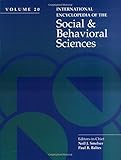 International encyclopedia of the social & behavioral sciences / editors-in-chief Neil J. Smelser and Paul B. Baltes. New York: Elsevier, 2001. 26 v. (lxxxvi, 16,695, 588, 898 p.) : ill., maps ; 26 cm.
International encyclopedia of the social & behavioral sciences / editors-in-chief Neil J. Smelser and Paul B. Baltes. New York: Elsevier, 2001. 26 v. (lxxxvi, 16,695, 588, 898 p.) : ill., maps ; 26 cm.If you aren't already familiar with this massive reference work, maybe you should be. It is massive (almost 17,000 pages), and it is online (if your library has a subscription). The coverage of archaeology is very good; archaeology is listed as a discipline of its own and not a subdiscipline of anthropology. I count 44 archaeology articles, most by recognized experts. These are categorized as follows:
- 8 regional syntheses
- 24 entries on "conceptual approaches"
- 12 entries on "methods and practice"
Puzzled about the relationship of poststructuralism and postmodernism (from some discussion on Savage Minds), I turned to the encyclopedia today while watching Florida beat Penn State. This entry turned out to be extremely useful for a social-theory-challenged guy like me:
- Mjøset, Lars (2001) Theory: Conceptions in the Social Sciences.
- law-oriented (covering-law approaches, promoted unsuccessfully by the new archaeologists);
- idealizing (economics, game theory, rational choice theory)
- constructivist (Geertzian anthropology, poststructuralism, postprocessual archaeology)
- critical theory (Frankfurt school).
Murphey's Law strikes again! Don't you hate it when you find an important and very relevant work just after your article is published? (I really wish I head read Mjøset before I completed my paper.) I almost added, "or after your term paper is submitted." But in the latter case, it is a blessing for students, since it gives you a head start when you return to your term paper to revise it for publication. Oh, you don't publish your term papers? Well why don't you get off your butt, stop reading blogs, and do something useful. Here is my logic: If a student has the ability, intelligence, drive, etc. to succeed as a scholar, then the chances are pretty good that such a person's term papers (with some additional work) are worthy of publication. If that is the case, then by NOT publishing them one is not only reducing one's academic chances, but also depriving the discipline of good research.
Here are a few other entries from the encyclopedia I have found useful:
- Bruegmann, Robert (2001) Urban Sprawl.
- Evans, Gary W. (2001) Crowding and Other Environmental Stressors.
- Jackman, R. W. (2001) Social Capital.
- Ostrom, Elinor (2001) Environment and Common Property Institutions.
- Wacquant, Loïc (2004) Ghetto. (This seems to be a kind of updated to the Encyclopedia)
- Wong, S. (2001) Cities, Internal Organization of.
Oh yes, I also found this gem today. In his entry "Postmodernism in Geography," postmodernist geographer Edward Soja says that poststructualism is just a "safer sounding label" for postmodernism.
7 comments:
I would have to read the article you mentioned to be sure what is meant by constructivism here, but I never associated it with postprocessual archaeology. Mostly I associate the term with Childe and 'man makes himself'. And we can know about what other civilizations made in a scientific manner. There is a longer argument about this stretching back to Vico (at least), all of which emphasizes science (if not necessarily the Cartesian variant).
Now it seems this word is being used for very different ways of approaching the past. Pretty disturbing, as I was going to use it in my thesis to denote the Childe-inspired approach. (which I happen to share)
This is social constructivism, something that Gordon Childe, as a Marxist, would certainly not have embraced. See
Houston, Stephen D. and Patricia A. McAnany (2003) Bodies and Blood: Critiquing Social Construction in Maya Archaeology. Journal of Anthropological Archaeology 22:26-41.
For an account from the philosophy of science, see:
Hacking, Ian (1999) The Social Construction of What? Harvard University Press, Cambridge.
This is a great resource, thanks for bringing it to our attention. Another resource that I use for similar purposes is the online Oxford Reference, which allows you to search dozens (depending on institutional subscription) of their reference works, including the Companion to Archaeology.
Thank you for the references. I had a very different notion of constructivism as 'man makes himself', deriving from my readings of Vico, Wittgenstein and Childe/Marxism. Maybe I will get off my lazy butt and write an article about it.
It is a deeply enclosed work, but is very useful (for the reasons you give) for those who can get to it. In our shop, Bauman's "Tradition, Anthropology of" gets a lot of use.
That article I mention does partake of the problem you mention in your other recent post. While about the anthropology of tradition it does not deal directly with the meanings of tradition in archaeology, either in the _Trend and Tradition_ sense or the _Archaeology of Traditions_ sense.
I offer the postscript by way of encouragement from a non-archaeologist. Some Americanists still attempt to know and actually engage with more than one sub-field.
Hi Mike, I just saw this post, and it looks like a great resource for social theory. However, I am surprised you didn't mention that, in their archaeology "Area Reviews," there is no entry for Mesoamerica, Latin America, Central America, South America, or anything south of "North America." Also, North America, in Lightfoot's definition, only encompasses northern Mexico, and thus excludes Mesoamerica. I hope they address this limited coverage in a the next edition.
Post a Comment